Accounting Systems and Processes: Finance Homework Solution
VerifiedAdded on 2020/04/01
|25
|1311
|33
Homework Assignment
AI Summary
This document presents a comprehensive solution to an accounting systems and processes assignment. It addresses various aspects of accounting, starting with naming cells in spreadsheets and their benefits for formula maintenance. The solution explores displaying negative numbers, designing spreadsheets for error minimization, and using the IF function for conditional statements. It also covers the periodic inventory system, including calculations for cost of goods sold. The assignment further delves into financial statement analysis, including direct write-off and allowance methods for bad debts, and evaluating an organization's financial position using receivables. The final section provides an analysis of Wesfarmers' financial performance, discussing dividends, return on equity, earnings per share, working capital ratio, and net profit tax, culminating in an investment recommendation for an individual. The document includes formula views, normal views, and workings for clarity.
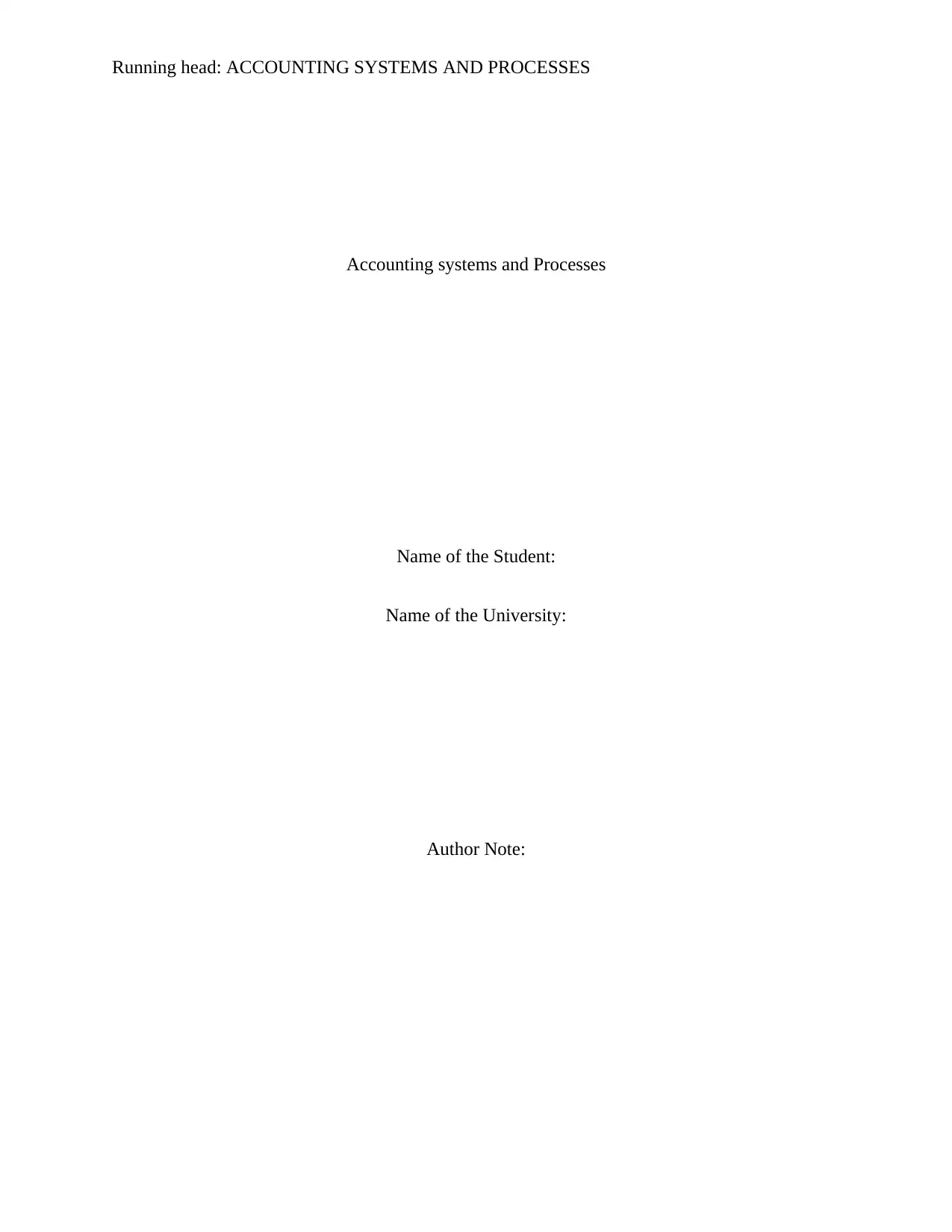
Running head: ACCOUNTING SYSTEMS AND PROCESSES
Accounting systems and Processes
Name of the Student:
Name of the University:
Author Note:
Accounting systems and Processes
Name of the Student:
Name of the University:
Author Note:
Paraphrase This Document
Need a fresh take? Get an instant paraphrase of this document with our AI Paraphraser
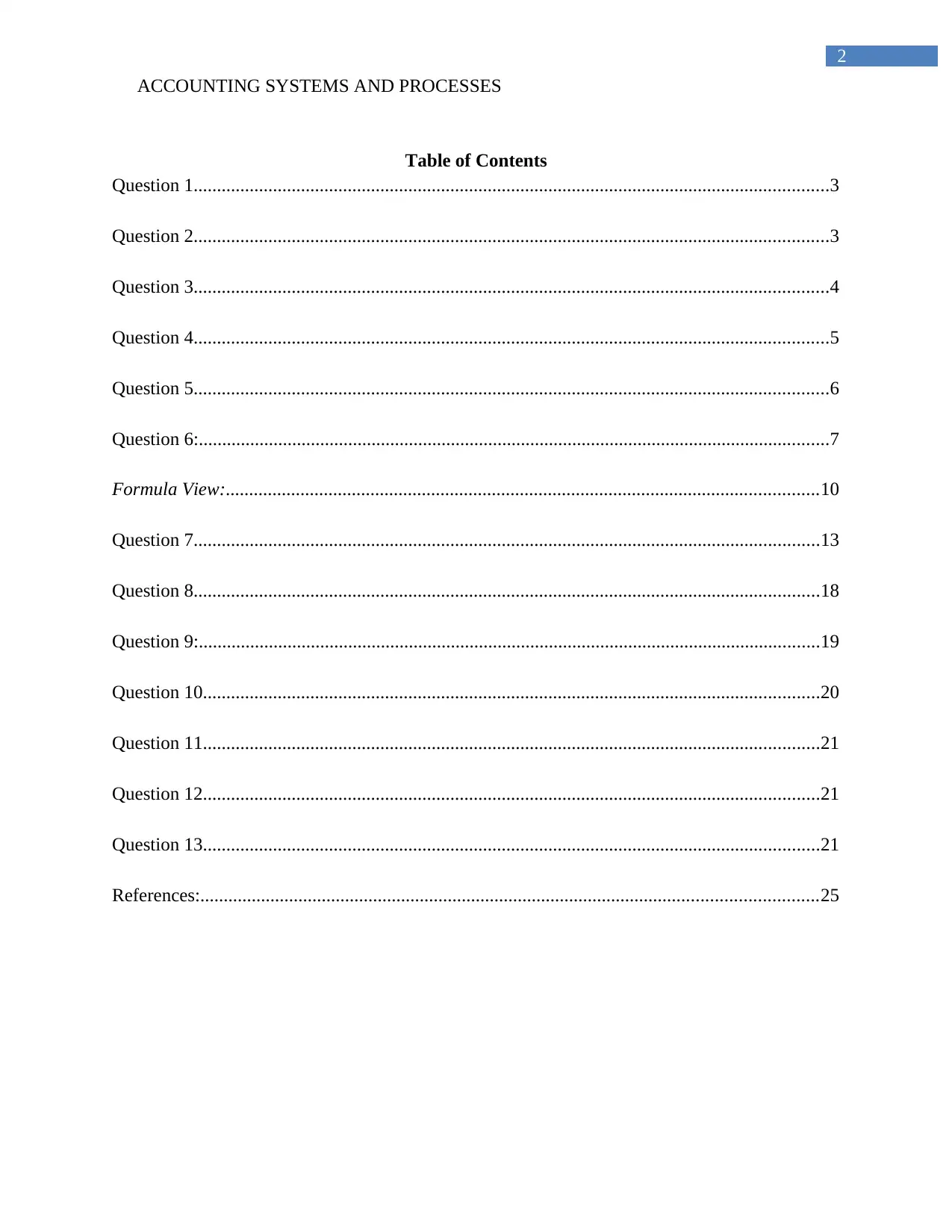
2
ACCOUNTING SYSTEMS AND PROCESSES
Table of Contents
Question 1........................................................................................................................................3
Question 2........................................................................................................................................3
Question 3........................................................................................................................................4
Question 4........................................................................................................................................5
Question 5........................................................................................................................................6
Question 6:.......................................................................................................................................7
Formula View:...............................................................................................................................10
Question 7......................................................................................................................................13
Question 8......................................................................................................................................18
Question 9:.....................................................................................................................................19
Question 10....................................................................................................................................20
Question 11....................................................................................................................................21
Question 12....................................................................................................................................21
Question 13....................................................................................................................................21
References:....................................................................................................................................25
ACCOUNTING SYSTEMS AND PROCESSES
Table of Contents
Question 1........................................................................................................................................3
Question 2........................................................................................................................................3
Question 3........................................................................................................................................4
Question 4........................................................................................................................................5
Question 5........................................................................................................................................6
Question 6:.......................................................................................................................................7
Formula View:...............................................................................................................................10
Question 7......................................................................................................................................13
Question 8......................................................................................................................................18
Question 9:.....................................................................................................................................19
Question 10....................................................................................................................................20
Question 11....................................................................................................................................21
Question 12....................................................................................................................................21
Question 13....................................................................................................................................21
References:....................................................................................................................................25
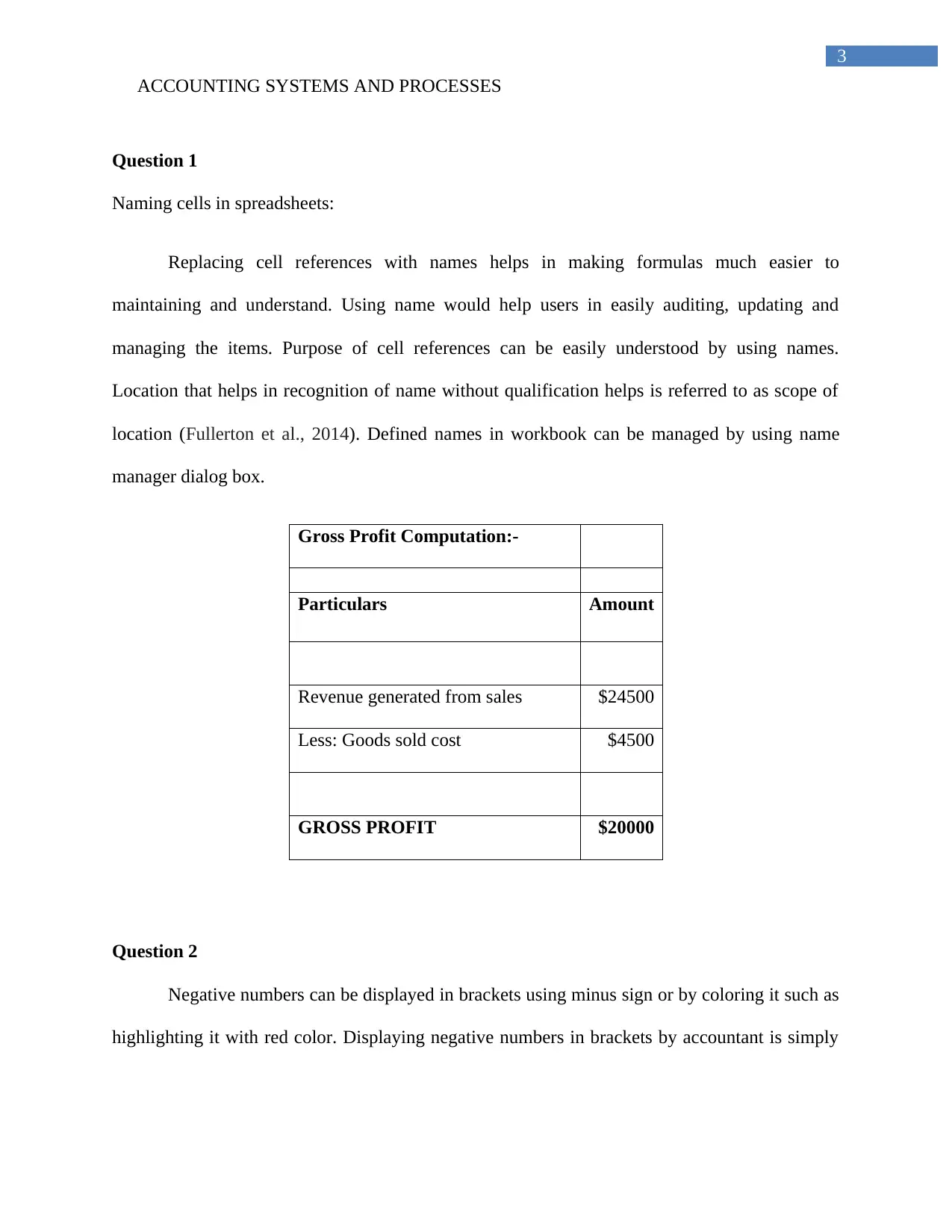
3
ACCOUNTING SYSTEMS AND PROCESSES
Question 1
Naming cells in spreadsheets:
Replacing cell references with names helps in making formulas much easier to
maintaining and understand. Using name would help users in easily auditing, updating and
managing the items. Purpose of cell references can be easily understood by using names.
Location that helps in recognition of name without qualification helps is referred to as scope of
location (Fullerton et al., 2014). Defined names in workbook can be managed by using name
manager dialog box.
Gross Profit Computation:-
Particulars Amount
Revenue generated from sales $24500
Less: Goods sold cost $4500
GROSS PROFIT $20000
Question 2
Negative numbers can be displayed in brackets using minus sign or by coloring it such as
highlighting it with red color. Displaying negative numbers in brackets by accountant is simply
ACCOUNTING SYSTEMS AND PROCESSES
Question 1
Naming cells in spreadsheets:
Replacing cell references with names helps in making formulas much easier to
maintaining and understand. Using name would help users in easily auditing, updating and
managing the items. Purpose of cell references can be easily understood by using names.
Location that helps in recognition of name without qualification helps is referred to as scope of
location (Fullerton et al., 2014). Defined names in workbook can be managed by using name
manager dialog box.
Gross Profit Computation:-
Particulars Amount
Revenue generated from sales $24500
Less: Goods sold cost $4500
GROSS PROFIT $20000
Question 2
Negative numbers can be displayed in brackets using minus sign or by coloring it such as
highlighting it with red color. Displaying negative numbers in brackets by accountant is simply
⊘ This is a preview!⊘
Do you want full access?
Subscribe today to unlock all pages.

Trusted by 1+ million students worldwide
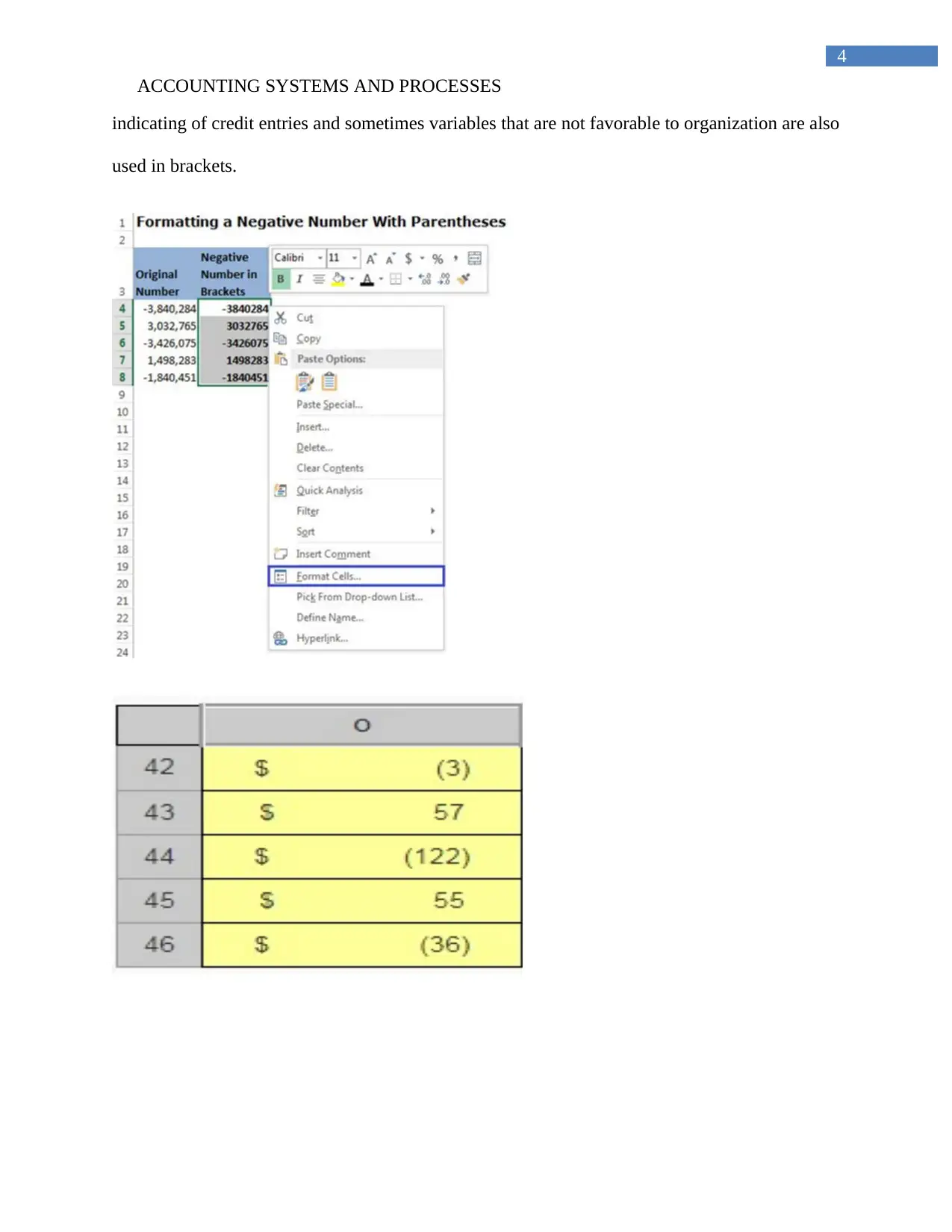
4
ACCOUNTING SYSTEMS AND PROCESSES
indicating of credit entries and sometimes variables that are not favorable to organization are also
used in brackets.
ACCOUNTING SYSTEMS AND PROCESSES
indicating of credit entries and sometimes variables that are not favorable to organization are also
used in brackets.
Paraphrase This Document
Need a fresh take? Get an instant paraphrase of this document with our AI Paraphraser
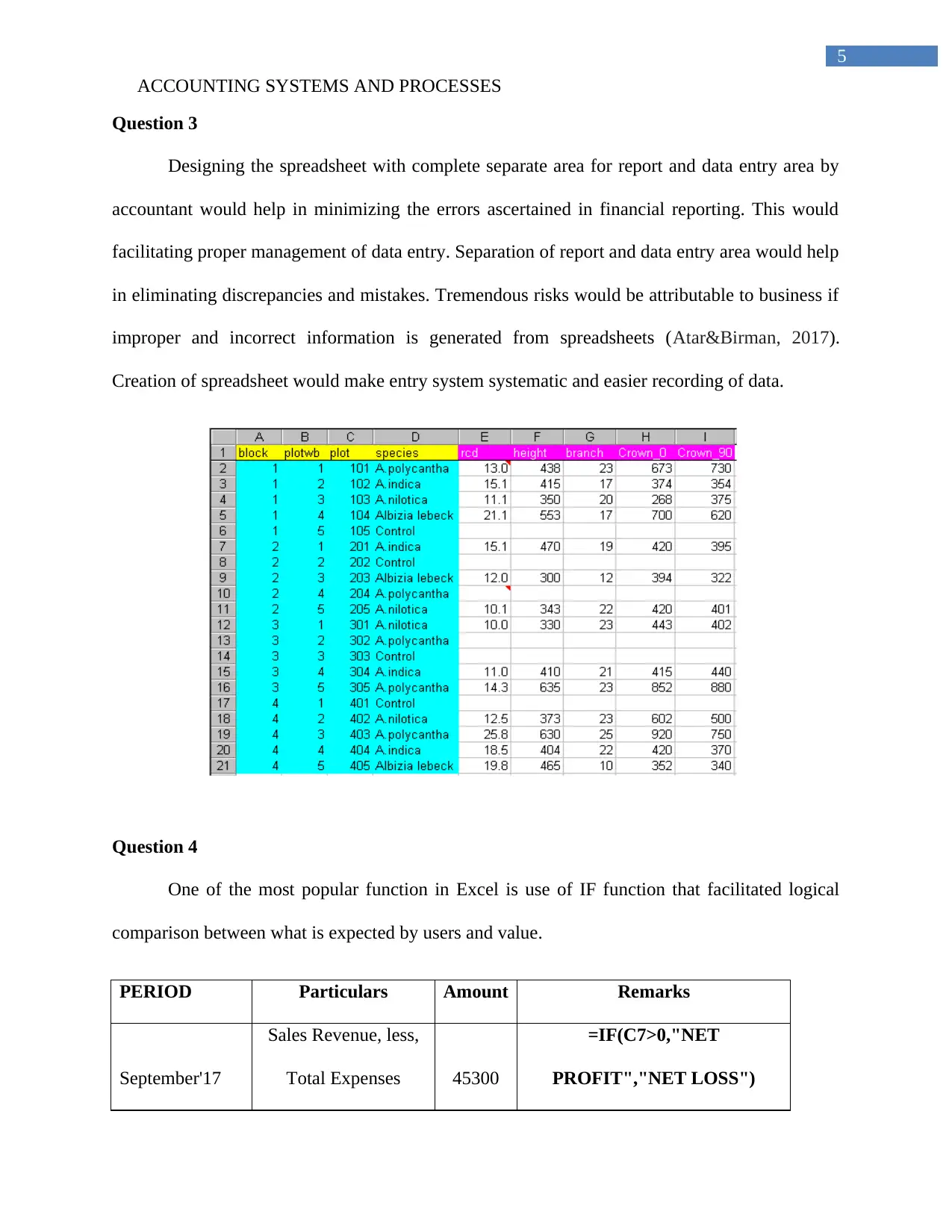
5
ACCOUNTING SYSTEMS AND PROCESSES
Question 3
Designing the spreadsheet with complete separate area for report and data entry area by
accountant would help in minimizing the errors ascertained in financial reporting. This would
facilitating proper management of data entry. Separation of report and data entry area would help
in eliminating discrepancies and mistakes. Tremendous risks would be attributable to business if
improper and incorrect information is generated from spreadsheets (Atar&Birman, 2017).
Creation of spreadsheet would make entry system systematic and easier recording of data.
Question 4
One of the most popular function in Excel is use of IF function that facilitated logical
comparison between what is expected by users and value.
PERIOD Particulars Amount Remarks
September'17
Sales Revenue, less,
Total Expenses 45300
=IF(C7>0,"NET
PROFIT","NET LOSS")
ACCOUNTING SYSTEMS AND PROCESSES
Question 3
Designing the spreadsheet with complete separate area for report and data entry area by
accountant would help in minimizing the errors ascertained in financial reporting. This would
facilitating proper management of data entry. Separation of report and data entry area would help
in eliminating discrepancies and mistakes. Tremendous risks would be attributable to business if
improper and incorrect information is generated from spreadsheets (Atar&Birman, 2017).
Creation of spreadsheet would make entry system systematic and easier recording of data.
Question 4
One of the most popular function in Excel is use of IF function that facilitated logical
comparison between what is expected by users and value.
PERIOD Particulars Amount Remarks
September'17
Sales Revenue, less,
Total Expenses 45300
=IF(C7>0,"NET
PROFIT","NET LOSS")
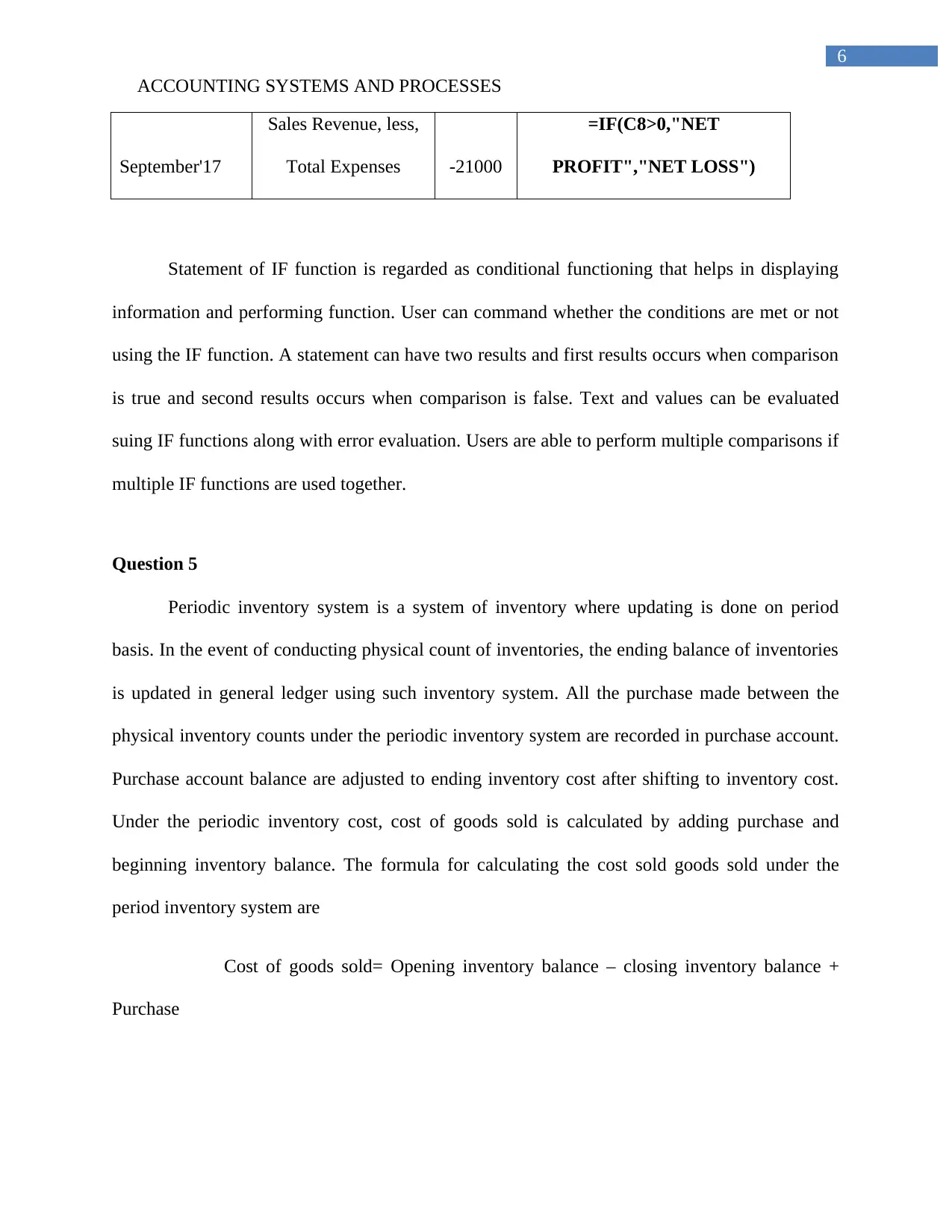
6
ACCOUNTING SYSTEMS AND PROCESSES
September'17
Sales Revenue, less,
Total Expenses -21000
=IF(C8>0,"NET
PROFIT","NET LOSS")
Statement of IF function is regarded as conditional functioning that helps in displaying
information and performing function. User can command whether the conditions are met or not
using the IF function. A statement can have two results and first results occurs when comparison
is true and second results occurs when comparison is false. Text and values can be evaluated
suing IF functions along with error evaluation. Users are able to perform multiple comparisons if
multiple IF functions are used together.
Question 5
Periodic inventory system is a system of inventory where updating is done on period
basis. In the event of conducting physical count of inventories, the ending balance of inventories
is updated in general ledger using such inventory system. All the purchase made between the
physical inventory counts under the periodic inventory system are recorded in purchase account.
Purchase account balance are adjusted to ending inventory cost after shifting to inventory cost.
Under the periodic inventory cost, cost of goods sold is calculated by adding purchase and
beginning inventory balance. The formula for calculating the cost sold goods sold under the
period inventory system are
Cost of goods sold= Opening inventory balance – closing inventory balance +
Purchase
ACCOUNTING SYSTEMS AND PROCESSES
September'17
Sales Revenue, less,
Total Expenses -21000
=IF(C8>0,"NET
PROFIT","NET LOSS")
Statement of IF function is regarded as conditional functioning that helps in displaying
information and performing function. User can command whether the conditions are met or not
using the IF function. A statement can have two results and first results occurs when comparison
is true and second results occurs when comparison is false. Text and values can be evaluated
suing IF functions along with error evaluation. Users are able to perform multiple comparisons if
multiple IF functions are used together.
Question 5
Periodic inventory system is a system of inventory where updating is done on period
basis. In the event of conducting physical count of inventories, the ending balance of inventories
is updated in general ledger using such inventory system. All the purchase made between the
physical inventory counts under the periodic inventory system are recorded in purchase account.
Purchase account balance are adjusted to ending inventory cost after shifting to inventory cost.
Under the periodic inventory cost, cost of goods sold is calculated by adding purchase and
beginning inventory balance. The formula for calculating the cost sold goods sold under the
period inventory system are
Cost of goods sold= Opening inventory balance – closing inventory balance +
Purchase
⊘ This is a preview!⊘
Do you want full access?
Subscribe today to unlock all pages.

Trusted by 1+ million students worldwide
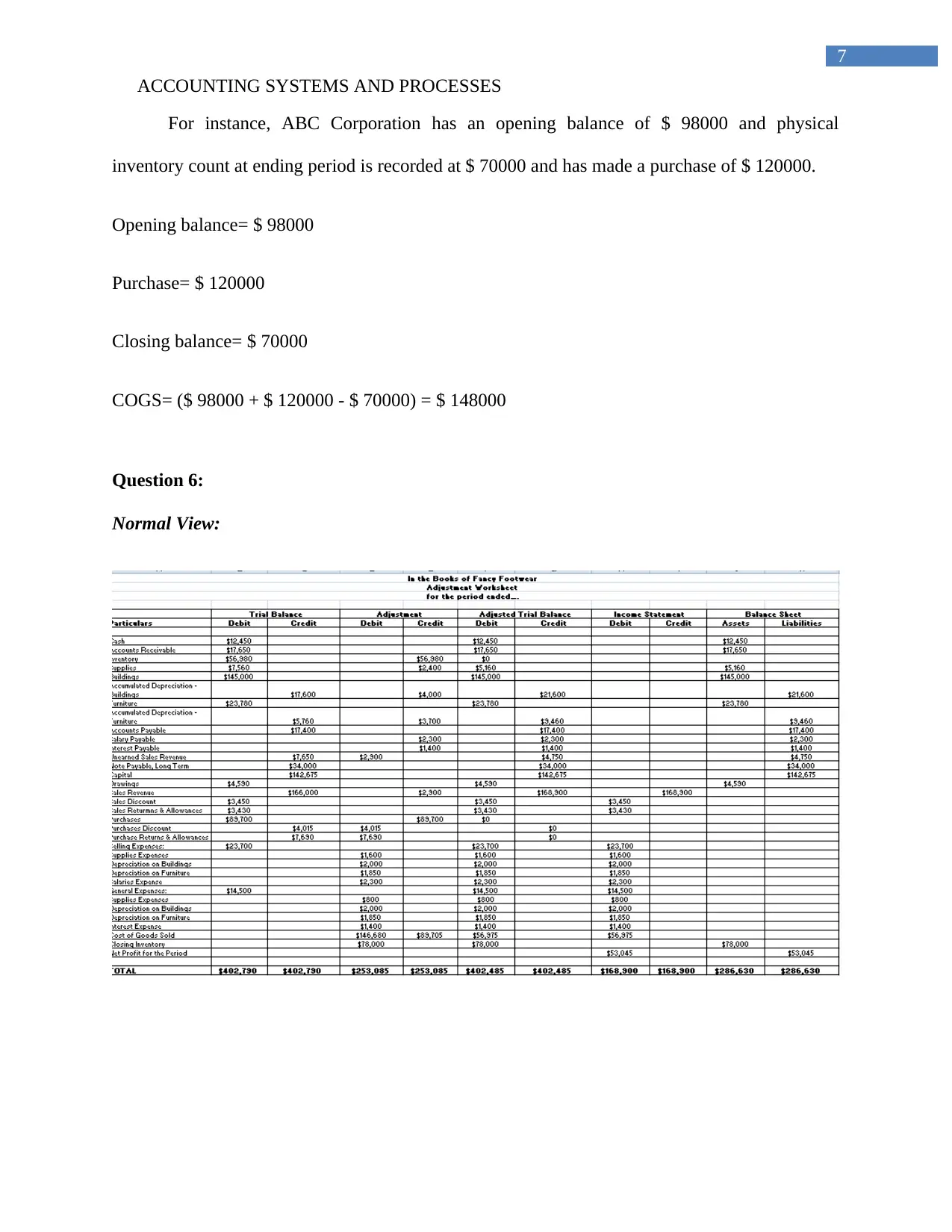
7
ACCOUNTING SYSTEMS AND PROCESSES
For instance, ABC Corporation has an opening balance of $ 98000 and physical
inventory count at ending period is recorded at $ 70000 and has made a purchase of $ 120000.
Opening balance= $ 98000
Purchase= $ 120000
Closing balance= $ 70000
COGS= ($ 98000 + $ 120000 - $ 70000) = $ 148000
Question 6:
Normal View:
ACCOUNTING SYSTEMS AND PROCESSES
For instance, ABC Corporation has an opening balance of $ 98000 and physical
inventory count at ending period is recorded at $ 70000 and has made a purchase of $ 120000.
Opening balance= $ 98000
Purchase= $ 120000
Closing balance= $ 70000
COGS= ($ 98000 + $ 120000 - $ 70000) = $ 148000
Question 6:
Normal View:
Paraphrase This Document
Need a fresh take? Get an instant paraphrase of this document with our AI Paraphraser
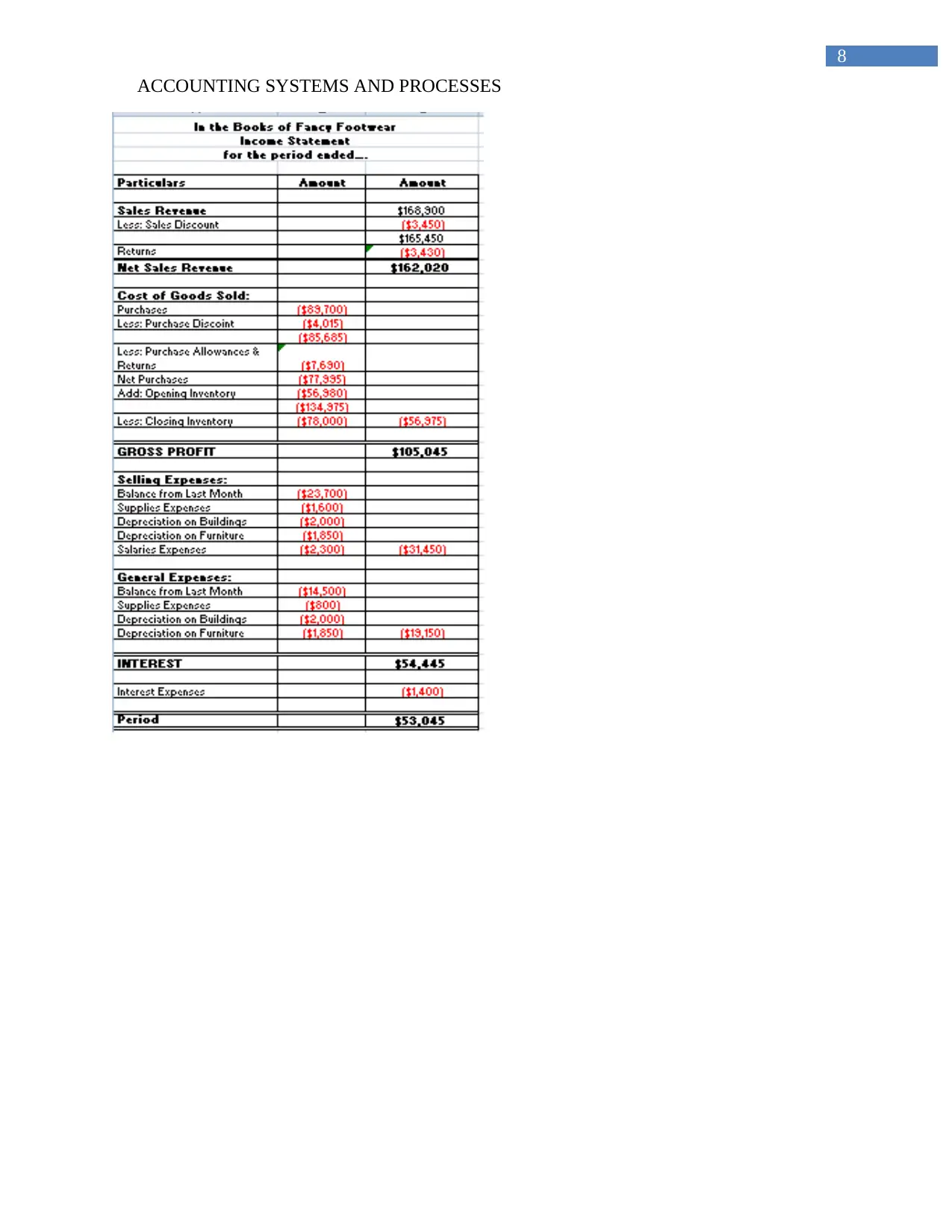
8
ACCOUNTING SYSTEMS AND PROCESSES
ACCOUNTING SYSTEMS AND PROCESSES
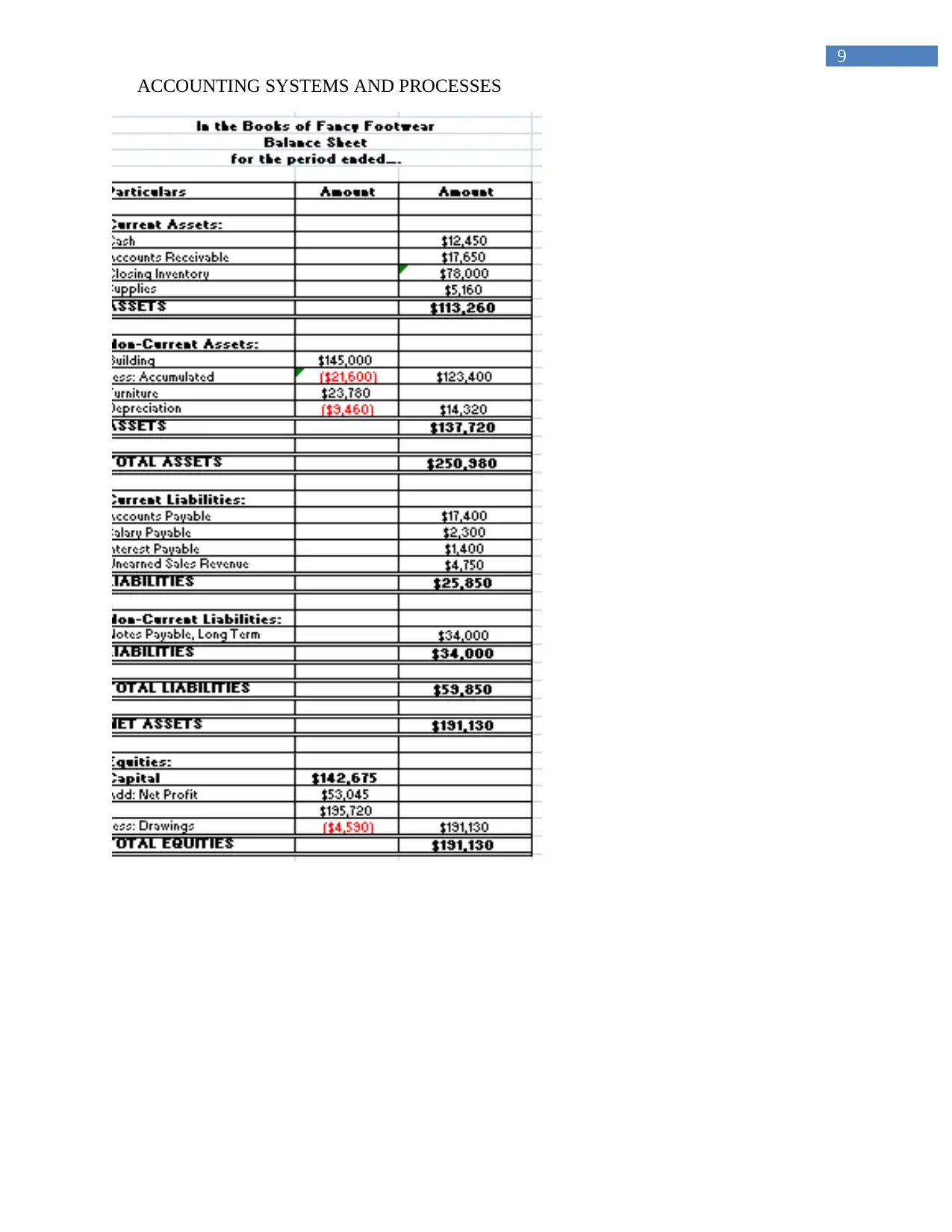
9
ACCOUNTING SYSTEMS AND PROCESSES
ACCOUNTING SYSTEMS AND PROCESSES
⊘ This is a preview!⊘
Do you want full access?
Subscribe today to unlock all pages.

Trusted by 1+ million students worldwide
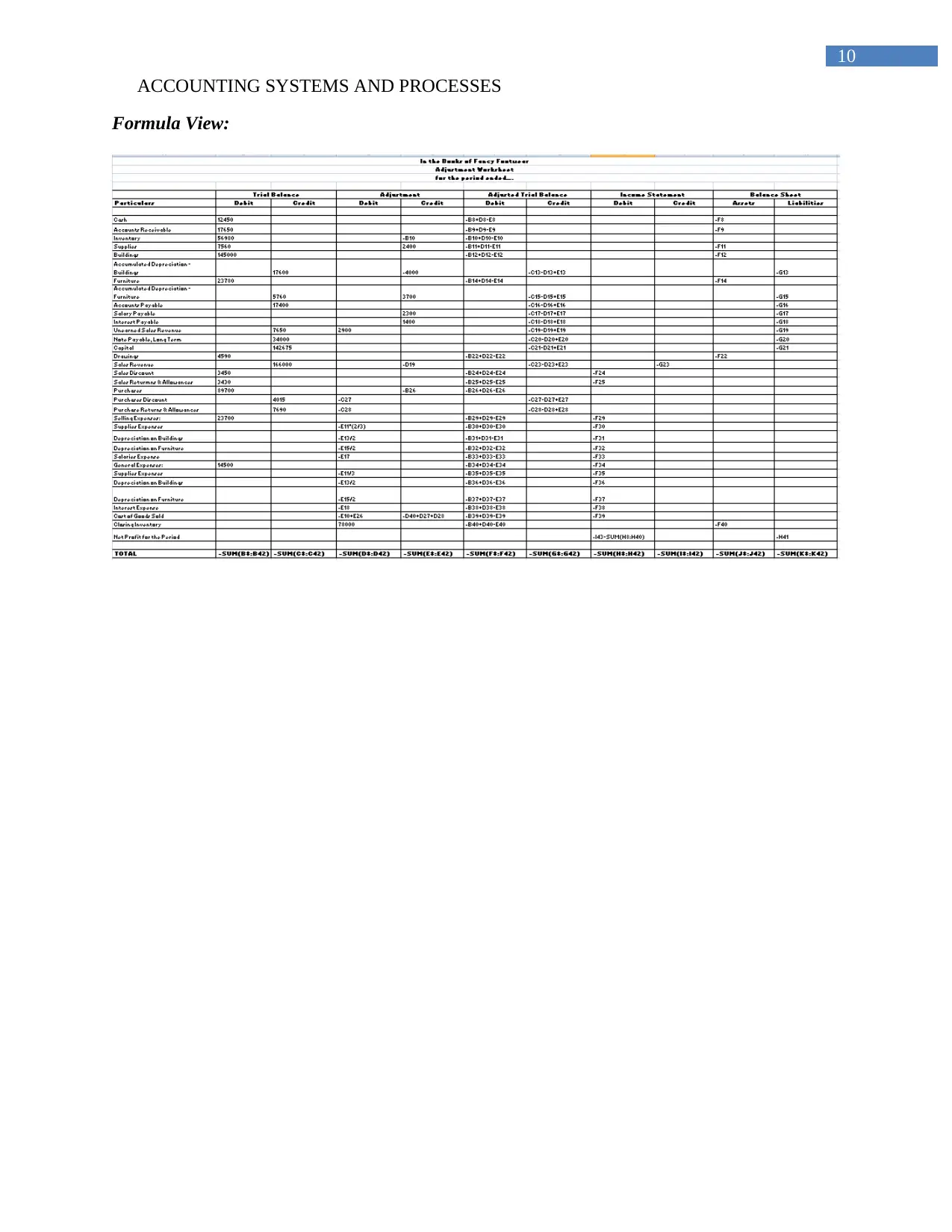
10
ACCOUNTING SYSTEMS AND PROCESSES
Formula View:
ACCOUNTING SYSTEMS AND PROCESSES
Formula View:
Paraphrase This Document
Need a fresh take? Get an instant paraphrase of this document with our AI Paraphraser
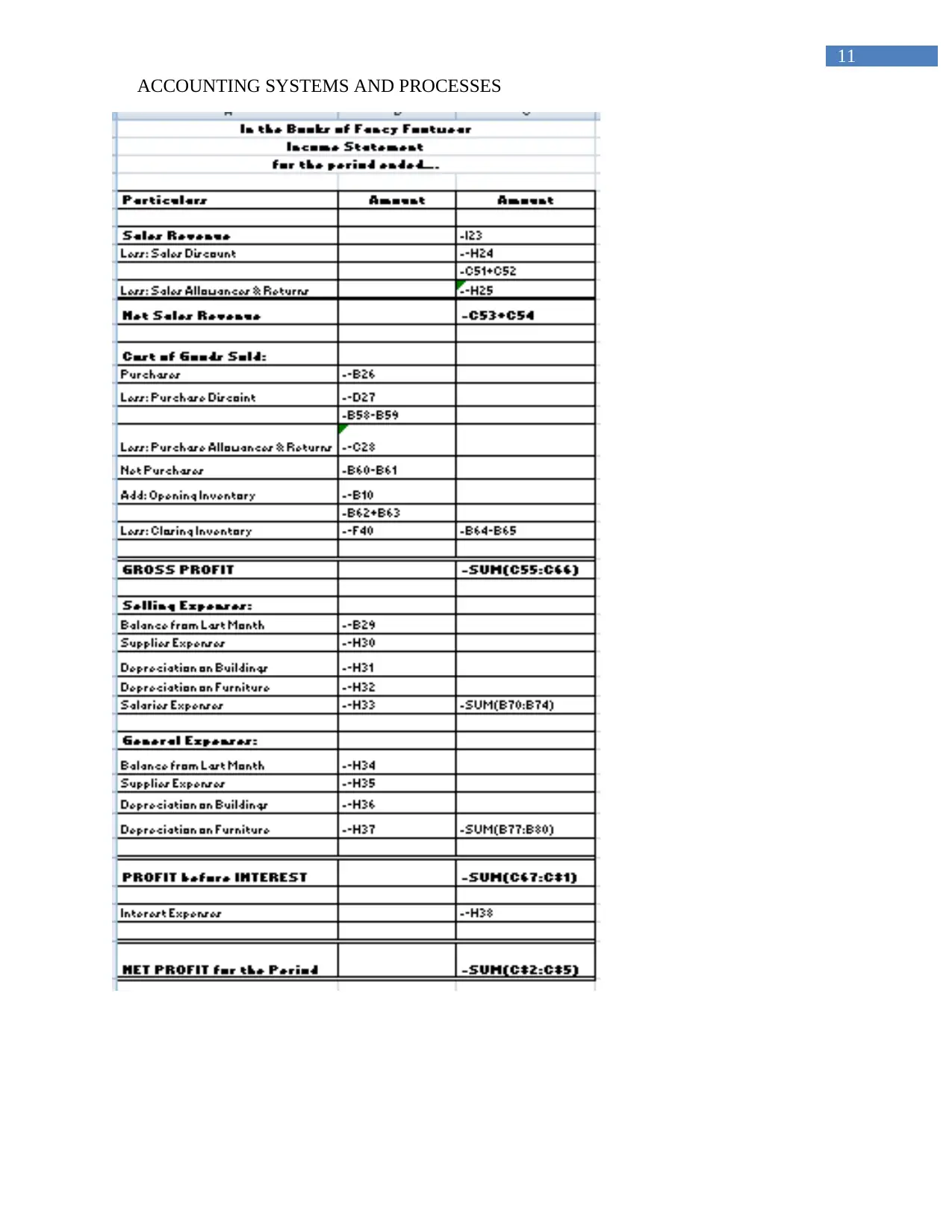
11
ACCOUNTING SYSTEMS AND PROCESSES
ACCOUNTING SYSTEMS AND PROCESSES
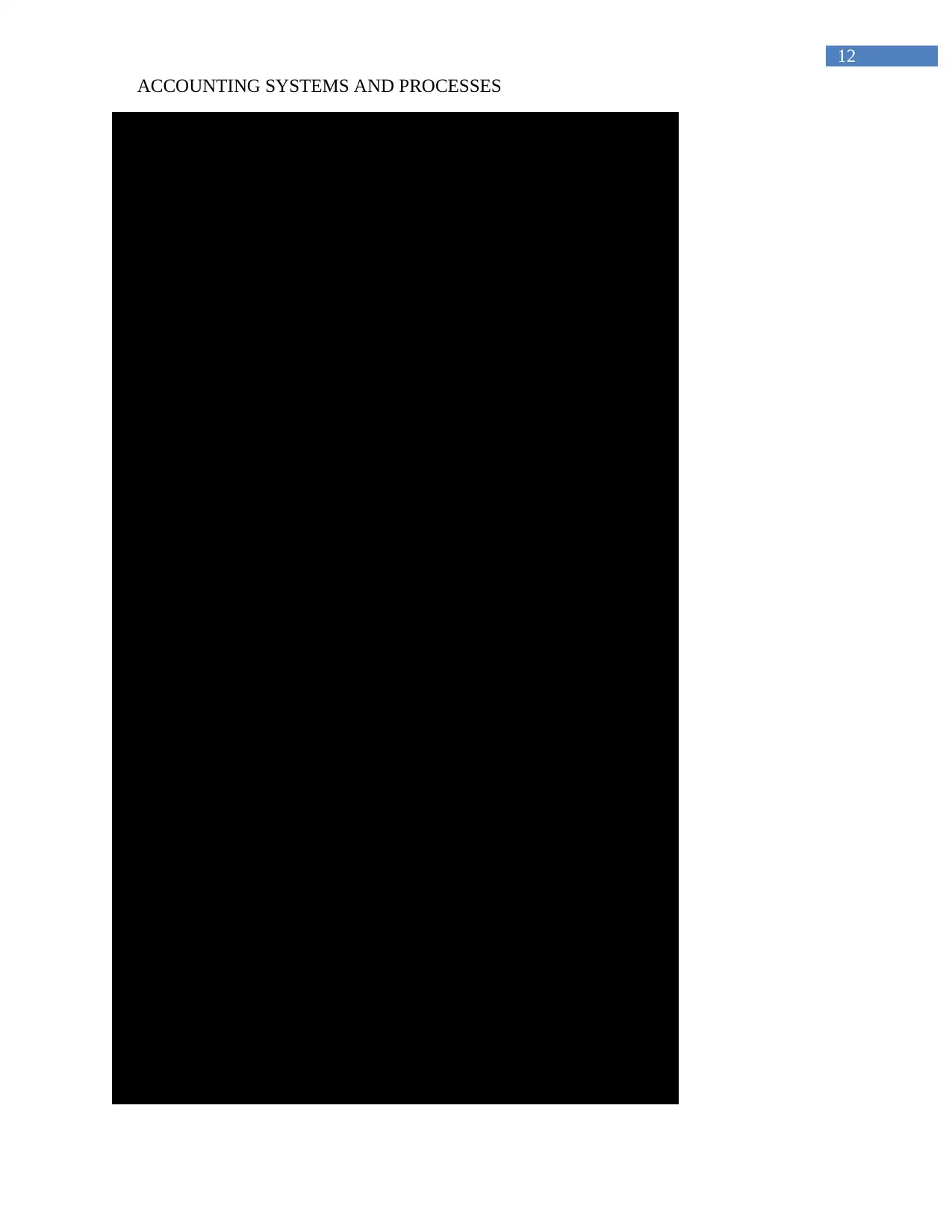
12
ACCOUNTING SYSTEMS AND PROCESSES
Particulars Amount Amount
Current Assets:
Cash =J8
Accounts Receivable =J9
Closing Inventory =F40
Supplies =J11
TOTAL CURRENT ASSETS =SUM(C95:C98)
Non-Current Assets:
Building =J12
Less: Accumulated Depreciation =-K13 =B102+B103
Furniture =J14
Less: Accumulated Depreciation =-K15 =B104+B105
TOTAL NON-CURRENT ASSETS =SUM(C103:C105)
TOTAL ASSETS =C99+C106
Current Liabilities:
Accounts Payable =K16
Salary Payable =K17
Interest Payable =K18
Unearned Sales Revenue =K19
TOTAL CURRENT LIABILITIES =SUM(C111:C114)
Non-Current Liabilities:
Notes Payable, Long Term =K20
TOTAL NON-CURRENT LIABILITIES =SUM(C116:C118)
TOTAL LIABILITIES =C119+C115
NET ASSETS =C108-C121
Equities:
Capital =K21
Add: Net Profit =K41
=B126+B127
Less: Drawings =-J22 =B128+B129
TOTAL EQUITIES =SUM(C125:C129)
for the period ended….
In the Books of Fancy Footwear
Balance Sheet
ACCOUNTING SYSTEMS AND PROCESSES
Particulars Amount Amount
Current Assets:
Cash =J8
Accounts Receivable =J9
Closing Inventory =F40
Supplies =J11
TOTAL CURRENT ASSETS =SUM(C95:C98)
Non-Current Assets:
Building =J12
Less: Accumulated Depreciation =-K13 =B102+B103
Furniture =J14
Less: Accumulated Depreciation =-K15 =B104+B105
TOTAL NON-CURRENT ASSETS =SUM(C103:C105)
TOTAL ASSETS =C99+C106
Current Liabilities:
Accounts Payable =K16
Salary Payable =K17
Interest Payable =K18
Unearned Sales Revenue =K19
TOTAL CURRENT LIABILITIES =SUM(C111:C114)
Non-Current Liabilities:
Notes Payable, Long Term =K20
TOTAL NON-CURRENT LIABILITIES =SUM(C116:C118)
TOTAL LIABILITIES =C119+C115
NET ASSETS =C108-C121
Equities:
Capital =K21
Add: Net Profit =K41
=B126+B127
Less: Drawings =-J22 =B128+B129
TOTAL EQUITIES =SUM(C125:C129)
for the period ended….
In the Books of Fancy Footwear
Balance Sheet
⊘ This is a preview!⊘
Do you want full access?
Subscribe today to unlock all pages.

Trusted by 1+ million students worldwide
1 out of 25
Related Documents
Your All-in-One AI-Powered Toolkit for Academic Success.
+13062052269
info@desklib.com
Available 24*7 on WhatsApp / Email
![[object Object]](/_next/static/media/star-bottom.7253800d.svg)
Unlock your academic potential
Copyright © 2020–2025 A2Z Services. All Rights Reserved. Developed and managed by ZUCOL.





